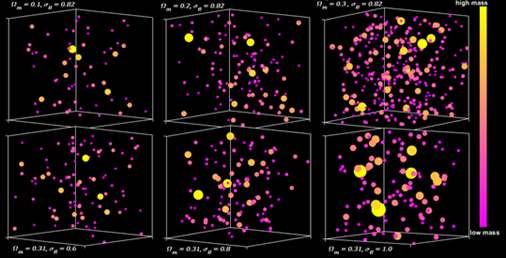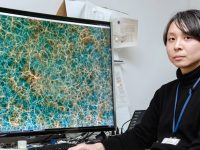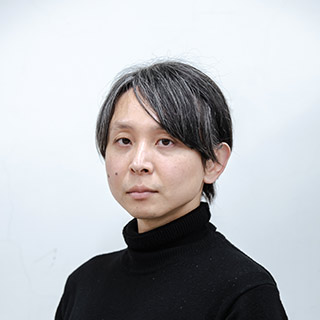A research team relies on measuring the number of galaxy members to determine the mass of galaxy clusters
One of the most interesting and important questions in cosmology is, “How much matter exists in the universe?” An international team, including scientists at Chiba University, has now succeeded in measuring the total amount of matter for the second time. Reporting in The Astrophysical Journal, the team determined that matter makes up 31% of the total amount of matter and energy in the universe, with the remainder consisting of dark energy.
“Cosmologists believe that only about 20% of the total matter is made of regular or ‘baryonic’ matter, which includes stars, galaxies, atoms, and life,” explains first author Dr. Mohamed Abdullah, a researcher at the National Research Institute of Astronomy and Geophysics-Egypt, Chiba University, Japan. “About 80% is made of dark matter, whose mysterious nature is not yet known but may consist of some as-yet-undiscovered subatomic particles.” (Fig. 1)
“The team used a well-proven technique to determine the total amount of matter in the universe, which is to compare the observed number and mass of galaxy clusters per unit volume with predictions from numerical simulations,” says co-author Gillian Wilson, Abdullah’s former graduate advisor and Professor of Physics and Vice Chancellor for research, innovation, and economic development at UC Merced. “The number of clusters observed at the present time, the so-called ‘cluster abundance,’ is very sensitive to cosmological conditions and, in particular, the total amount of matter.”
“A higher percentage of the total matter in the universe would result in more clusters being formed,” says Anatoly Klypin from University of Virginia. “But it is difficult to measure the mass of any galaxy cluster accurately as most of the matter is dark, and we cannot see it directly with telescopes.”
To overcome this difficulty, the team was forced to use an indirect tracer of cluster mass. They relied upon the fact that more massive clusters contain more galaxies than less massive clusters (mass richness relation: MRR). Because galaxies consist of luminous stars, the number of galaxies in each cluster can be utilized as a way of indirectly determining its total mass. By measuring the number of galaxies in each cluster in their sample from the Sloan Digital Sky Survey, the team was able to estimate the total mass of each of the clusters. They were then able to compare the observed number and mass of galaxy clusters per unit volume against predictions from numerical simulations. The best-fit match between observations and simulations was with a universe consisting of 31% of the total matter, a value that was in excellent agreement with that obtained using cosmic microwave background (CMB) observations from the Planck satellite. Notably, CMB is a completely independent technique.
“We have succeeded in making the first measurement of matter density using the MRR, which is in excellent agreement with that obtained by the Planck team using the CMB method,” says Tomoaki Ishiyama from Chiba University. “This work further demonstrates that cluster abundance is a competitive technique for constraining cosmological parameters and complementary to non-cluster techniques such as CMB anisotropies, baryon acoustic oscillations, Type Ia supernovae, or gravitational lensing.”
The team credits their achievement as being the first to successfully utilize spectroscopy, the technique that separates radiation into a spectrum of individual bands or colors, to precisely determine the distance to each cluster and the true member galaxies that are gravitationally bound to the cluster rather than background or foreground interlopers along the line of sight. Previous studies that attempted to use the MRR technique relied on much cruder and less accurate imaging techniques, such as using pictures of the sky taken at some wavelengths, to determine the distance to each cluster and the nearby galaxies that were true members.
The paper, published in The Astrophysical Journal, not only demonstrates that the MRR technique is a powerful tool for determining cosmological parameters but also explains how it can be applied to new datasets that are available from large, wide, and deep-field imaging, and spectroscopic galaxy surveys such as those performed with Subaru Telescope, Dark Energy Survey, Dark Energy Spectroscopic Instrument, Euclid Telescope, eROSITA Telescope, and the James Webb Space Telescope.
Reference:
Title: Constraining Cosmological Parameters using the Cluster Mass-Richness Relation
Authors: Mohamed H. Abdullah, Gillian Wilson, Anatoly Klypin, and Tomoaki Ishiyama
Journal: The Astrophysical Journal
DOI: 10.3847/1538-4357/ace773

Image title: The dependence of the number of galaxy clusters on the total amount of matter.
Image caption: Like Goldilocks, the team compared the number of galaxy clusters measured with predictions from numerical simulations to determine which answer was “just right.”
Image credit: Mohamed Abdullah (The National Research Institute of Astronomy and Geophysics, Egypt/Chiba University, Japan)
Image license: CC-BY 4.0
About Associate Professor Tomoaki Ishiyama
Tomoaki Ishiyama is an Associate Professor at the Digital Transformation Enhancement Council, Chiba University. His research focuses on elucidating the formation and evolution of various astronomical objects, such as galaxies and large-scale structures of the universe, as well as the study of dark matter structures within galaxies. His simulation movie showcasing the formation of dark matter structure has garnered over 300,000 views on YouTube.
Funding Information:
This project is supported by the IAAR Research Support Program in Chiba University, Japan, MEXT/JSPS KAKENHI (Grant Number JP19KK0344, JP21H01122, and JP21F51024), MEXT as “Program for Promoting Research on the Supercomputer Fugaku” (JPMXP1020200109), JICFuS, National Science Foundation, and NASA.
Contact: Tomoaki Ishiyama
Digital Transformation Enhancement Council
Email: ishiyama@chiba-u.jp
Tel: +81 43-290-3543
Public Relations Office, Chiba University
Address: 1-33 Yayoi, Inage, Chiba 263-8522 JAPAN
Email: koho-press@chiba-u.jp
Tel: +81-43-290-2018
Recommend
-

Optimizing End-of-Life Happiness: The Future of Nursing through Technology
2024.05.31
-

Unveiling the Truth of the Universe through Simulated Catalogs: Unleashing the Power of a Theoretical Telescope, ‘Supercomputer’
2023.08.07
-

Listening to the Voices of the Universe: Multi-Messenger Astrophysics with Gravitational and Electromagnetic Waves
2025.05.16


